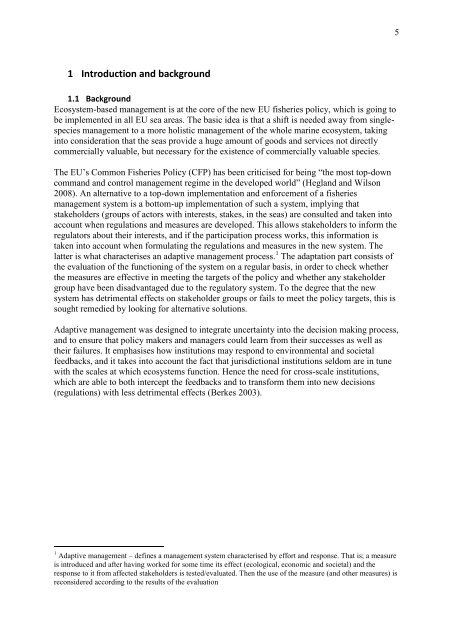Operational tools and adaptive management
Operational tools and adaptive management
Operational tools and adaptive management
You also want an ePaper? Increase the reach of your titles
YUMPU automatically turns print PDFs into web optimized ePapers that Google loves.
1 Introduction <strong>and</strong> background<br />
1.1 Background<br />
Ecosystem-based <strong>management</strong> is at the core of the new EU fisheries policy, which is going to<br />
be implemented in all EU sea areas. The basic idea is that a shift is needed away from singlespecies<br />
<strong>management</strong> to a more holistic <strong>management</strong> of the whole marine ecosystem, taking<br />
into consideration that the seas provide a huge amount of goods <strong>and</strong> services not directly<br />
commercially valuable, but necessary for the existence of commercially valuable species.<br />
The EU‟s Common Fisheries Policy (CFP) has been criticised for being “the most top-down<br />
comm<strong>and</strong> <strong>and</strong> control <strong>management</strong> regime in the developed world” (Hegl<strong>and</strong> <strong>and</strong> Wilson<br />
2008). An alternative to a top-down implementation <strong>and</strong> enforcement of a fisheries<br />
<strong>management</strong> system is a bottom-up implementation of such a system, implying that<br />
stakeholders (groups of actors with interests, stakes, in the seas) are consulted <strong>and</strong> taken into<br />
account when regulations <strong>and</strong> measures are developed. This allows stakeholders to inform the<br />
regulators about their interests, <strong>and</strong> if the participation process works, this information is<br />
taken into account when formulating the regulations <strong>and</strong> measures in the new system. The<br />
latter is what characterises an <strong>adaptive</strong> <strong>management</strong> process. 1 The adaptation part consists of<br />
the evaluation of the functioning of the system on a regular basis, in order to check whether<br />
the measures are effective in meeting the targets of the policy <strong>and</strong> whether any stakeholder<br />
group have been disadvantaged due to the regulatory system. To the degree that the new<br />
system has detrimental effects on stakeholder groups or fails to meet the policy targets, this is<br />
sought remedied by looking for alternative solutions.<br />
Adaptive <strong>management</strong> was designed to integrate uncertainty into the decision making process,<br />
<strong>and</strong> to ensure that policy makers <strong>and</strong> managers could learn from their successes as well as<br />
their failures. It emphasises how institutions may respond to environmental <strong>and</strong> societal<br />
feedbacks, <strong>and</strong> it takes into account the fact that jurisdictional institutions seldom are in tune<br />
with the scales at which ecosystems function. Hence the need for cross-scale institutions,<br />
which are able to both intercept the feedbacks <strong>and</strong> to transform them into new decisions<br />
(regulations) with less detrimental effects (Berkes 2003).<br />
1 Adaptive <strong>management</strong> – defines a <strong>management</strong> system characterised by effort <strong>and</strong> response. That is; a measure<br />
is introduced <strong>and</strong> after having worked for some time its effect (ecological, economic <strong>and</strong> societal) <strong>and</strong> the<br />
response to it from affected stakeholders is tested/evaluated. Then the use of the measure (<strong>and</strong> other measures) is<br />
reconsidered according to the results of the evaluation<br />
5

















